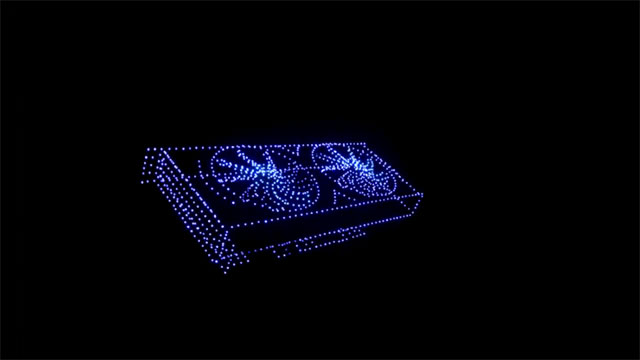Intel ARC Xe-HPG 'Alchemist' GPU Leak: High Performance, Launching in 2022
Intel ARC's mainstream product line will be dedicated discrete graphics cards, targeting gamers who are looking for the best performance and experience from its hardware setup.
The US semiconductor giant has also confirmed that the first ARC products will be launched in the first quarter of 2022, codenamed 'Alchemist', or otherwise based on the platform. 'Alchemist' (Xe-HPG). Currently, the first information about this Intel ARC Alchemist GPU model has also begun to be revealed on many major technology forums. This gives a relatively detailed look at Intel's highly anticipated debut product, as well as partly answers the question of how the device will compete with rivals from NVIDIA or AMD.
 Intel ARC Xe-HPG 'Alchemist' GPU Leak: High Performance, Launching in 2022 Picture 1
Intel ARC Xe-HPG 'Alchemist' GPU Leak: High Performance, Launching in 2022 Picture 1
 Intel ARC Xe-HPG 'Alchemist' GPU Leak: High Performance, Launching in 2022 Picture 2
Intel ARC Xe-HPG 'Alchemist' GPU Leak: High Performance, Launching in 2022 Picture 2
Talking about the design first, Intel held a pretty impressive drone demonstration as a form of marketing for its ARC brand launch event. On stage, the drones lined up together in the shape of a graphics card, pretty much the same as a leaked design that went viral on the internet a few months ago. This GPU model is likely to have a dual-slot design and a dual-fan system. The front part has curves that are synchronized with the fan set to increase the aesthetics of the product. Notably, the GPU's cooling fan will have 9 blades, similar to previous leaked information.
In terms of performance, this variant is rumored to be a flagship GPU with 4096 cores and up to 16GB of GDDR6 memory. The leaked image shows a large aluminum heatsink, accompanied by a small acrylic plate with the Intel logo engraved on it. Power connector configuration is 8 + 6 with TDP up to 275W. Of course, these parameters are completely subject to change in the final variant released, but the deviation probably won't be much.
 Intel ARC Xe-HPG 'Alchemist' GPU Leak: High Performance, Launching in 2022 Picture 3
Intel ARC Xe-HPG 'Alchemist' GPU Leak: High Performance, Launching in 2022 Picture 3
 Intel ARC Xe-HPG 'Alchemist' GPU Leak: High Performance, Launching in 2022 Picture 4
Intel ARC Xe-HPG 'Alchemist' GPU Leak: High Performance, Launching in 2022 Picture 4
As mentioned, this flagship Alchemist 512 EU variant has only one configuration listed so far, and uses a full die set with 4096 cores, a 256-bit bus interface and up to 16GB of GDDR6 memory. The Alchemist 512 EU chip is expected to be around 396mm2, which is larger than the AMD RDNA 2 and NVIDIA Ampere products. Based on demand and output, Intel may launch more variants, but this cannot be confirmed.
The Xe-HPG Alchemist 512 EU chip is said to be clocked up to 2.2GHz, although it's unclear if this is average or maximum. In addition, it is reported that Intel's original TDP target was 225-250W but has now been raised to around 275W. We can also expect a 300W variant with dual 8-pin connectors if Intel wants to push the clocks of the product even higher. Similar to competitors, Intel will also equip dedicated hardware on the Alchemist GPU to provide supersampling technology that supports Raytracing & AI.
In a nutshell, Intel's Xe-HPG Alchemist lineup will essentially compete head-to-head with NVIDIA & AMD RDNA's Ampere GPUs. The lineup will also be coming to mobile platforms, and will be featured in the Alder Lake-P notebooks launching in 2022.
TipsMake.com will continue to update information about this GPU model. Welcome to invite your attention to read!
You should read it
- Intel Arc 'Alchemist' GPU Will Come With DisplayPort 2.0, Support Up To 16K Display Resolution
- Top 5 best Intel CPUs 2022
- What's the difference between Intel Core and Intel Core X CPUs?
- Unfair competition, Intel was fined EUR 1.06 billion in Europe
- Intel will unveil the 'new computing era' at IFA 2014
- Intel launched a super-saving computer model priced from 3 million
- Intel's 9th generation microprocessor can be released on October 1
- What is the Intel NUC?
- What is Intel's new Core i9 CPU line?
- Researchers found a way to disable Intel ME
- Intel is back with foldable laptops
- Apple surpassed Intel because Intel just sat there
May be interested

Botnets can change CPU settings to increase mining performance

Leaked benchmark results of AMD Radeon RX 6700M 'Navi 22' laptop GPU

NBMiner releases 'hack' that can restore 70% of 'mining' performance on NVIDIA's Ampere LHR GPU

Revealed Intel Core i9-12900K Alder Lake-S CPU configuration with 16 cores, 24 threads, supports DDR4 RAM

Why is the Galaxy Z Flip 3 not equipped with an under-screen camera that the Galaxy Z Fold 3 has?

AMD Radeon RX 6600 XT - the next 'monster' in the world of crypto mining!






 Intel Arc 'Alchemist' GPU Will Come With DisplayPort 2.0, Support Up To 16K Display Resolution
Intel Arc 'Alchemist' GPU Will Come With DisplayPort 2.0, Support Up To 16K Display Resolution What is Intel XeSS? How does Nvidia DLSS compare?
What is Intel XeSS? How does Nvidia DLSS compare? Difference between ARM and Intel x86-64
Difference between ARM and Intel x86-64 Which CPU to choose to meet both price and performance requirements?
Which CPU to choose to meet both price and performance requirements? What does leak mean?
What does leak mean? Revealed Intel Core i9-12900K Alder Lake-S CPU configuration with 16 cores, 24 threads, supports DDR4 RAM
Revealed Intel Core i9-12900K Alder Lake-S CPU configuration with 16 cores, 24 threads, supports DDR4 RAM